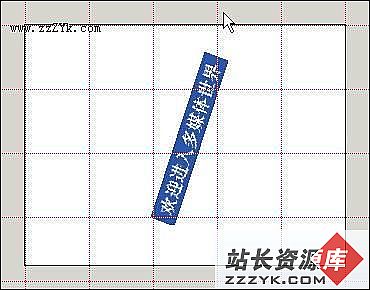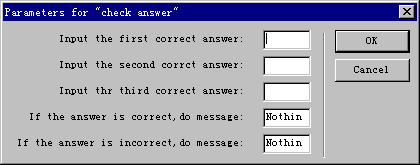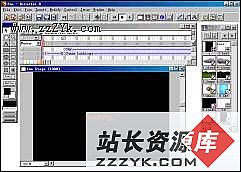Director 编写“拼图游戏”(2)
Director 编写“拼图游戏”首先,我们需要自己编写几个函数(或个人句柄)。
第一个函数是生成 16 个随机列表的函数 generateList。
它的具体代码如下:
on generateList
global gEmpty,randomList
set randomList = []
repeat with x = 1 to 16
addAt(randomList,random(x),x)
end repeat
end
因为 Lingo 没有提供对列表随机排列的功能,所以这里使用了来自 Tab Julius 先生的《Lingo !高级指南》中的一段代码,它非常巧妙地通过循环语句中使用 addAt(),random()函数生成随机列表。它在循环中先随机产生列表位置,并将其赋予 1-16 中的值,当 addAt()函数向列表中相同位置添加值时,它会将位置推后,这种特殊的工作方式将不会出现重复现象。
第二个函数也是最重要的一个函数 exchange()。 它有一个参数, . 此参数为通道号。当在一个与空白垂直或水平相邻的拼图上单击时,应将二者的角色对换,即,空白所在的通道将角色换为被单击的通道的角色,而单击的通道的角色换为空白。并将被单击的通道号赋予标识空白所在通道的变量 gEmpty。函数中的变量 x 为临时变量,用于作替换时暂存数据。
on exchange n
global gEmpty
set x to the memberNum of sprite gEmpty
set the memberNum of sprite gEmpty to the memberNum of sprite n
set the memberNum of sprite n to x
updatestage
set gEmpty = n
end
此函数用在每个循环帧中 1-16 号通道,用法如下:
on mouseup
if inList(1) then
exchange 1
puppetsound "click"
end if
end
这里用到了另一个编写的函数 inList(),此函数用于判别当前被单击的通道是否在可移动列表 M 中,如果是在列表 M 中,则返回 TRUE。
函数 inList() 代码如下:
on inList cnt
set countnum = count(M)
repeat with x = 1 to countnum
if cnt = getAt(M,x) then
return TRUE
exit repeat
end if
end repeat
end
其中M 为当前可移动通道号列表,首先函数使用count()函数计算列表 M 中成员的个数,并将其赋予变量 countnum,变量 countnum 为循环检测的终止变量。循环语句中,判定 inList() 的参数 cnt 是否在列表 M 中。如果在其中,则返回 TRUE,并退出循环。
另外一个函数是 move(),它将返回当前可移动通道列表。
on move sth
return getAt(mList,sth)
end
它根据空白所在通道号来返回当前可移动拼图通道号列表。这里我使用了一个二维列表 mList = [m1,m2,m3,m4,m5,m6,m7,m8,m9,m10,m11,m12,m13,m14,m15,m16],其中 m1,m2,m3, ……为空白在 1,2,3,4,5, …..时,可移动通道号列表。举例,如第一张图,当空白处为 16 号通道,可以移动的通道为 12 和 15 ,即,m16 = [12,15]。所有这些列表将在on startmovie 事件句柄中初始化。具体代码如下:
on startMovie
global gEmpty,randomList,First,Finish,Tmp,m1,m2,m3,m4,m5,
m6,m7,m8,m9,m10,m11,m12,m13,m14,m15,m16,mList,M
set M = []
set Tmp = []
set Finish = [1,2,3,4,5,6,7,8,9,10,11,12,13,14,15,16]
set m1 = [2,5]
set m2 = [1,3,6]
set m3 = [2,4,7]
set m4 = [3,8]
set m5 = [1,6,9]
set m6 = [2,5,7,10]
set m7 = [3,6,8,11]
set m8 = [4,7,12]
set m9 = [5,10,13]
set m10 = [6,9,11,14]
set m11 = [7,10,12,15]
[1] [2] 下一页
set m12 = [8,11,16]
set m13 = [9,14]
set m14 = [10,13,15]
set m15 = [11,14,16]
set m16 = [12,15]
set mList = [m1,m2,m3,m4,m5,m6,m7,m8,
m9,m10,m11,m12,m13,m14,m15,m16]
set First = 0
generateList
set gEmpty = getOne(randomList,16)
repeat with i = 1 to 16
puppetsprite i,TRUE
end repeat
end startMovie
< /SPAN >这段代码有几点需要说明:首先,初始化了列表和许多全局变量。其中First 变量赋予值 为 0 ,第一次进入循环帧时,需要根据 generteList 函数生成的随机角色列表 randomList来更新各个通道的角色,以产生每次进入游戏的随机图案;其次,使用 getOne() 函数获取全局变量 randomList 列表中 16号角色(即,空白角色)所在的通道号;最后,将所有 1 到 16 号通道木偶化。
上一页 [1] [2]
- 更多Director疑问解答:
- Director MX 2004教程--Director与Flash,竞争还是合作?
- Director MX 2004教程--常用多媒体编著软件
- Director MX 2004教程--哪些人适合使用Director
- 关于多媒体程序运行速度的研究
- 谈谈Director作品的发布模式
- Director MX 2004教程--用Lingo语法和javascript实现同一功能
- Director中的属性
- Director MX 2004教程--创建新的演员表
- Director 疑难解答(5)
- Director的“洋葱皮”技术介绍(2)
- Director的“洋葱皮”技术介绍(1)
- Director MX 2004教程--演员的管理
- Director MX 2004教程--演员窗口
- Director MX 2004教程--提高开发效率
- Director MX 2004教程--Director MX 2004都支持些什么?
部分文章来自网络,





